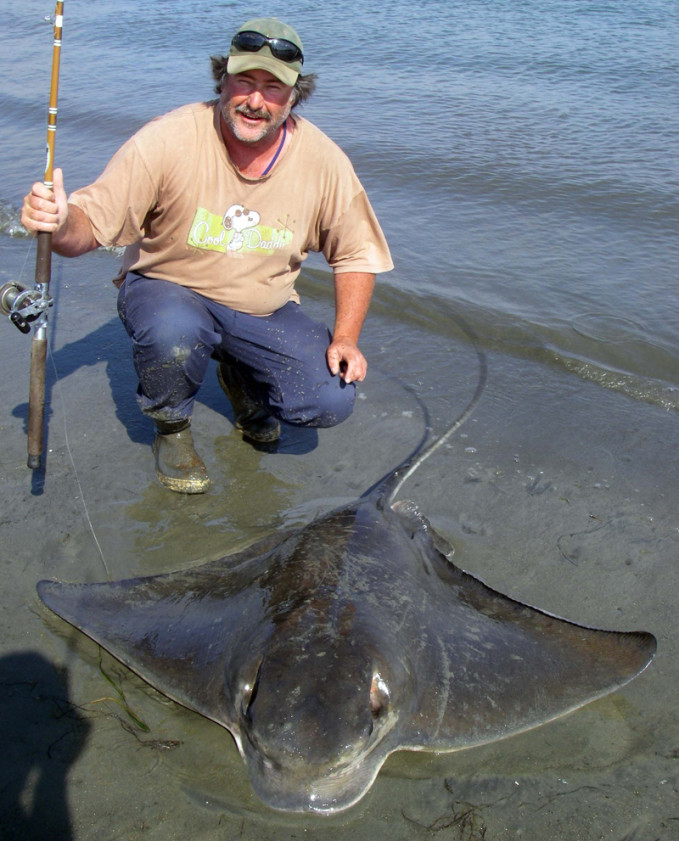
Bat Ray Fishing Southern California Bays
Here is a little information about how I fish for bat rays in Mission Bay. This isn’t the only way to do it, but it works for me, the guy who taught me much of it, and others whom I have shared these techniques with.
Why? Bat ray fishing in the bay is a fun way to spend some time outdoors. Sitting on the sand with a friend or two, watching the comings and goings of the bay, maybe even a bonfire. Add to that the chance of catching a fish in the 100 pound range or larger and you have the makings of a good time.
Tackle
Targeting bat rays means you may tie into fish over 4 feet across weighing 80-100 pounds or more so your gear needs to be able to handle that size fish. I prefer conventional gear, but they can be landed on spinning gear too if you are more comfortable using it.
I use mostly 40# test mono line. It is strong enough to pull in big fish and is fairly abrasion resistant. Sometimes I will use 30# mono, but the risk of losing fish is greater. Nobody likes to lose fish, even worse are the comments from the old salts along the lines of “30 pound? Hmmm.”
For rods, something that will handle 40# test and that you are able to cast will do. There is no need for expensive gear, or lightweight modern rods, though if you have them you might as well use them. Old tuna rods, jigsticks, or if you want a real workout, bring down the 12 foot surf rod.
Reels should be able to hold around 300 yds of 40 pound line. Enough for a good cast, a long powerful run, and some left over so you don’t get all nervous about getting spooled. Simple reels are best. Easy to maintain and able to perform with a little grit and grime without failing and sending you home for the evening. I have Daiwa Sealines, but friends use Penn 500 series with great success. Again, bring the new gear if you want, but most of the time the rod will be in the holder close to the sand, so durability trumps light weight in my mind.
Hooks should be big and strong. I like offset octopus hooks in 9/0 or 10/0 size. Big enough to pin 2 whole squid or a big chunk of mackerel on and leave some of the hook point exposed. Here I have found I prefer the designer hooks. Bat rays have bony plates for teeth and I have lost many fish, that I thought were solidly hooked, to cheap hooks bending on the teeth instead of penetrating.
To round off the tackle, you will need egg sinkers in 2-4 oz sizes, pyramid sinkers in 2-6 oz sizes, some heavy swivels in barrel and three-way styles, and some beads.
Rigs
I use three basic rigs, the cannonball rig, a modified fishfinder rig, and a three-way rig.
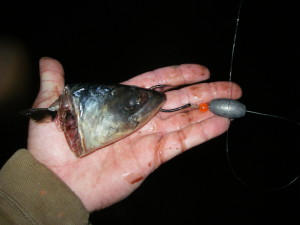 The simplest of these is the cannonball rig. Thread an egg sinker onto your mainline, then a small bead, then tie your hook on. Choose the size of the sinker by the amount of current. You want the sinker to be able to roll some to help position the bait in the current, but you don’t want it to be carried away. This rig is fished with the reel in freespool and with the clicker engaged.
The simplest of these is the cannonball rig. Thread an egg sinker onto your mainline, then a small bead, then tie your hook on. Choose the size of the sinker by the amount of current. You want the sinker to be able to roll some to help position the bait in the current, but you don’t want it to be carried away. This rig is fished with the reel in freespool and with the clicker engaged.
Next is the modified fishfinder rig. To make this rig, cut two pieces of line 2-21/2 feet long and tie a barrel swivel to one end of each of them. to the other end of one, tie your hook. For the second, tie a pyramid sinker to the end opposite the swivel. Again, let the current determine how much weight. The goal with this rig is to have your weight positioned in a specific location and allow you bait to drift away from it in the current without straying too far from where you place it. Also fish this rig in freespool with the clicker on.
The third rig I use is the three-way rig. To one eye of the three-way swivel tie about 2 feet of line with your hook on the other end, to another eye tie a roughly equal length of line with a pyramid sinker. The idea here is to keep the bait close to where you cast it. I fish this rig with the drag engaged, but at about half what I would use to fight the fish, also with the clicker on.
Where to Fish
When selecting a spot to fish, I prefer a sandy beach. Fishing from the rocks at night makes things more difficult. It also is pretty rough on the fish to land them on the rocks. I like to fish in channels and off points of land rather than off a long line of beach. Channels, because they have moving water and concentrate fish as they move about the bay. Points offer access to more water from a given location.
Choosing where to cast your bait once you have chosen your spot is not difficult. Just throw it out there. Bomb it as far as you can, or lob it out just a little ways. Both will work. As you fish a particular location, you may find that certain areas are more productive than others to place your bait. If the current is strong, or there are bits of floating eelgrass, a shorter cast will stay put longer, as will a rig that uses the pyramid sinker.
Bait
For me there are basically two choices for bait, squid, and mackerel. They both have produced well for me in the past, sometimes on the same night. Other nights, the fish seem to prefer one or the other so I like to have both available. I usually fish with two rods so to begin with I will use squid on one rod and mackerel on the other. If one seems to be getting bit more often I will use that on both rods.
Not all squid or mackerel are the same. I prefer bait that I caught myself, that way I know it is reasonably fresh. If I have to buy bait, I look for the best, fresh looking bait I can find. Markets that specialize in Asian foods are often a great source for both mackerel and squid, but they are not always convenient. If I go this route I tend to buy enough bait to last several sessions.Tackle shops usually have both baits available as well, however I usually stick to squid from the tackle shop as often the mackerel are larger than the 12-14 inch size that I prefer. This size allows 3-4 nice baits to be cut from it, but they are not so large that they are difficult to cast or tend to fall off the hook.



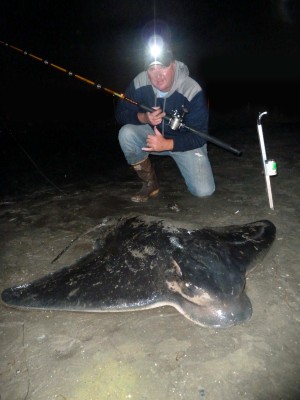
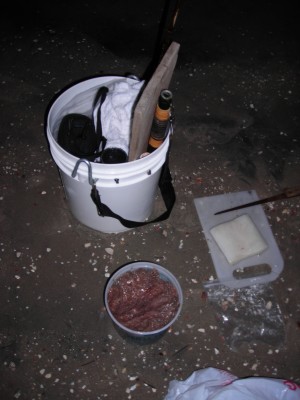



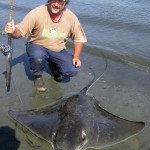
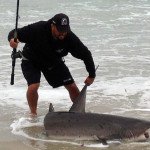
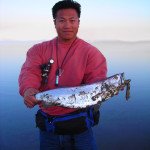
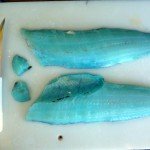
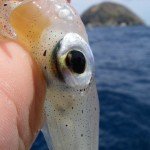
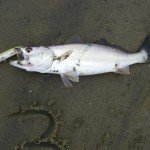
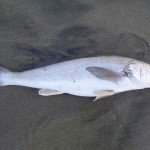

Most commented